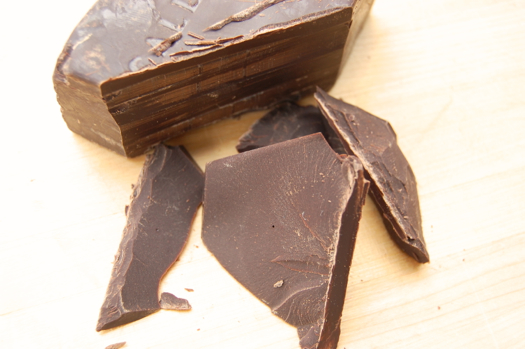Semi-Sweet Chocolate

Semi-sweet chocolate also goes by the name of “dark” chocolate, at least when it’s in candy bar form, though interestingly it often contains more sugar than even most milk chocolate. Semi-sweet chocolate is often 60% sugar by weight. The rest of its volume is made up of cocoa solids (about 15%) and cocoa butter (27-32%). Like bittersweet and unsweetened chocolate it has no milk solids in it, which I suppose is what makes it “dark” by some standards. Semi-sweet has fewer uses than bittersweet in my opinion, which I think is why you don’t see terribly much of it except as an inclusion in chocolate chip cookies, muffins, ice cream, that sort of thing. A lot of people just like to eat it, and really, who can blame them?
I should insert here once again that the definitions of bittersweet and semisweet tend to blur together in the US where, unlike Europe, there are no formal guidelines as to what constitutes either, and every chocolatier has its own set of standards. Your best bet for determining the relative darkness of a chocolate is to check the percentages on the packages which have become a de-facto standard in the industry the last twenty years or so.
Hey Joe! Can you explain about Cocoa Nibs? (what are they, uses in baking/eating?) They’re quite trendy and I see them used as a crunchy addition to doughnuts around Brooklyn, but other than that, are they good for anything else?
Hi Rachelle!
Good question. I mentioned nibs briefly in the “Chocolate Primer” below, basically they’re the kernels of the cacao seeds, the essence of chocolate, what coffee beans are to coffee. They’re the things chocolate makers roast and then grind to produce chocolate liquor. They don’t taste especially good to most people since they’re a.) intense and b.) not sweet. You’re right that they have gotten hip lately. Bakers put them in brownies and sprinkle them on cakes. However as they’re unsweetened cooks put them to work in savory contexts as well: on salads, in pastas and such, just about anywhere you might ordinarily see nuts.
Thanks for the question!
– Joe
I’ve always had trouble keeping unsweetened and bittersweet chocolate straight, but now I have to worry that both bittersweet and semi-sweet chocolate may be called “dark.” I guess I’ll have to learn how to read the labels for sugar weight/percentage, and ignore the names.
Hi Sandra!
If it’s called “bittersweet” then it must conform to the general formula I outlined in that post, if that’s any comfort. But if the bar is simply labeled “dark” then you’re on your own I’m afraid. You’ll have to rely on your taste buds to detect that wallop of sugar…which I bet you can! 😉
– Joe
If I grind cocoa nibs in my coffee grinder (because I think they’re truly awful, and gosh they were expensive), would that give me cocoa powder? Because then I could put it to good use. Currently they’re just hanging out on my shelf, because honestly? On their own, I think they’re yucky.
Hi Chana!
You will have a sort of cocoa powder, but not really cocoa powder. I wouldn’t make a cake or brownies with it, but if you could get it fairly fine you could conceivably use it to flavor something like ice cream!
Any help?
– Joe
I recently saw a flavoured tea that contained (among other things) cocoa nibs. I didn’t buy any, because it also had something else in it that I don’t like, but black tea with cocoa nibs sounds interesting – at least for those of us who like really bitter tea.
That does sound interesting. Mrs. Pastry would love that I think. Where did you see it? Might make a good birthday gift!
– joe